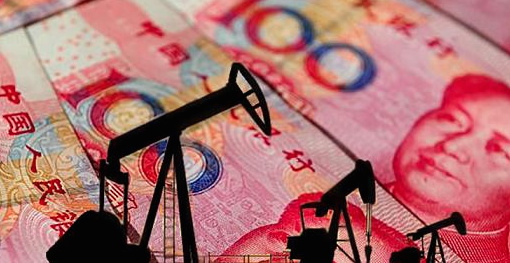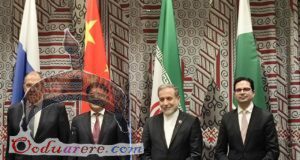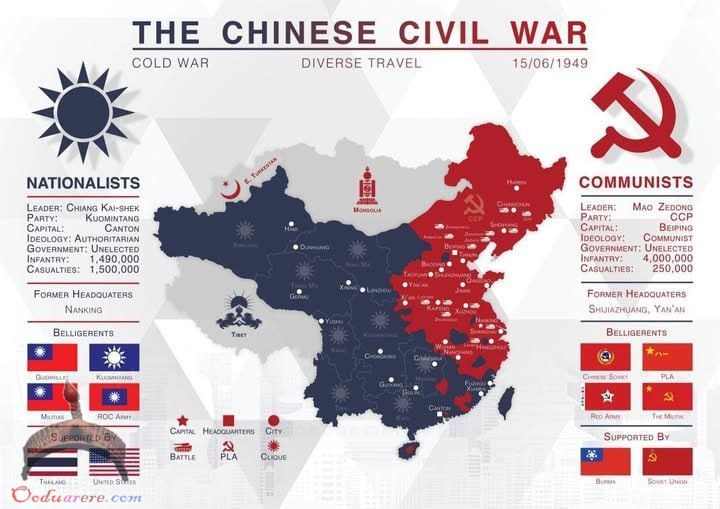by Pepe Escobar (cross-posted with the Asia Times by special agreement with the author)
The new 55-page “America First” National Security Strategy (NSS), drafted over the course of 2017, defines Russia and China as “revisionist” powers, “rivals”, and for all practical purposes strategic competitors of the United States.
The NSS stops short of defining Russia and China as enemies, allowing for an “attempt to build a great partnership with those and other countries”. Still, Beijing qualified it as “reckless” and “irrational.” The Kremlin noted its “imperialist character” and “disregard for a multipolar world”. Iran, predictably, is described by the NSS as “the world’s most significant state sponsor of terrorism.”
Russia, China and Iran happen to be the three key movers and shakers in the ongoing geopolitical and geoeconomic process of Eurasia integration.
The NSS can certainly be regarded as a response to what happened at the BRICS summit in Xiamen last September. Then, Russian President Vladimir Putin insisted on “the BRIC countries’ concerns over the unfairness of the global financial and economic architecture which does not give due regard to the growing weight of the emerging economies”, and stressed the need to “overcome the excessive domination of a limited number of reserve currencies”.
That was a clear reference to the US dollar, which accounts for nearly two thirds of total reserve currency around the world and remains the benchmark determining the price of energy and strategic raw materials.
And that brings us to the unnamed secret at the heart of the NSS; the Russia-China “threat” to the US dollar.
The CIPS/SWIFT face-off
The website of the China Foreign Exchange Trade System (CFETS) recently announced the establishment of a yuan-ruble payment system, hinting that similar systems regarding other currencies participating in the New Silk Roads, a.k.a. Belt and Road Initiative (BRI) will also be in place in the near future.
Crucially, this is not about reducing currency risk; after all Russia and China have increasingly traded bilaterally in their own currencies since the 2014 US-imposed sanctions on Russia. This is about the implementation of a huge, new alternative reserve currency zone, bypassing the US dollar.
The decision follows the establishment by Beijing, in October 2015, of the China International Payments System (CIPS). CIPS has a cooperation agreement with the private, Belgium-based SWIFT international bank clearing system, through which virtually every global transaction must transit.
What matters in this case is that Beijing – as well as Moscow – clearly read the writing on the wall when, in 2012, Washington applied pressure on SWIFT; blocked international clearing for every Iranian bank; and froze $100 billion in Iranian assets overseas as well as Tehran’s potential to export oil. In the event Washington might decide to slap sanctions on China, bank clearing though CIPS works as a de facto sanctions-evading mechanism.
Last March, Russia’s central bank opened its first office in Beijing. Moscow is launching its first $1 billion yuan-denominated government bond sale. Moscow has made it very clear it is committed to a long term strategy to stop using the US dollar as their primary currency in global trade, moving alongside Beijing towards what could be dubbed a post-Bretton Woods exchange system.
Gold is essential in this strategy. Russia, China, India, Brazil & South Africa are all either large producers or consumers of gold – or both. Following what has been extensively discussed in their summits since the early 2010s, the BRICS are bound to focus on trading physical gold.
Markets such as COMEX actually trade derivatives on gold, and are backed by an insignificant amount of physical gold. Major BRICS gold producers – especially the Russia-China partnership – plan to be able to exercise extra influence in setting up global gold prices.
The ultimate politically charged dossier
Intractable questions referring to the US dollar as top reserve currency have been discussed at the highest levels of JP Morgan for at least five years now. There cannot be a more politically charged dossier. The NSS duly sidestepped it.
The current state of play is still all about the petrodollar system; since last year what used to be a key, “secret” informal deal between the US and the House of Saud is firmly in the public domain.
Even warriors in the Hindu Kush may now be aware of how oil and virtually all commodities must be traded in US dollars, and how these petrodollars are recycled into US Treasuries. Through this mechanism Washington has accumulated an astonishing $20 trillion in debt – and counting.
Vast populations all across MENA (Middle East-Northern Africa) also learned what happened when Iraq’s Saddam Hussein decided to sell oil in euros, or when Muammar Gaddafi planned to issue a pan-African gold dinar.
But now it’s China who’s entering the fray, following on plans set up way back in 2012. And the name of the game is oil-futures trading priced in yuan, with the yuan fully convertible into gold on the Shanghai and Hong Kong foreign exchange markets.
The Shanghai Futures Exchange and its subsidiary, the Shanghai International Energy Exchange (INE) have already run four production environment tests for crude oil futures. Operations were supposed to start at the end of 2017; but even if they start sometime in early 2018 the fundamentals are clear; this triple win (oil/yuan/gold) completely bypasses the US dollar. The era of the petro-yuan is at hand.
Of course there are questions on how Beijing will technically manage to set up a rival mark to Brent and WTI, or whether China’s capital controls will influence it. Beijing has been quite discreet on the triple win; the petro-yuan was not even mentioned in National Development and Reform Commission documents following the 19th CCP Congress last October.
What’s certain is that the BRICS supported the petro-yuan move at their summit in Xiamen, as diplomats confirmed to Asia Times. Venezuela is also on board. It’s crucial to remember that Russia is number two and Venezuela is number seven among the world’s Top Ten oil producers. Considering the pull of China’s economy, they may soon be joined by other producers.
Yao Wei, chief China economist at Societe Generale in Paris, goes straight to the point, remarking how “this contract has the potential to greatly help China’s push for yuan internationalization.”
The hidden riches of “belt” and “road”
An extensive report by DBS in Singapore hits most of the right notes linking the internationalization of the yuan with the expansion of BRI.
In 2018, six major BRI projects will be on overdrive; the Jakarta-Bandung high-speed railway, the China-Laos railway, the Addis Ababa-Djibouti railway, the Hungary-Serbia railway, the Melaka Gateway project in Malaysia, and the upgrading of Gwadar port in Pakistan.
HSBC estimates that BRI as a whole will generate no less than an additional, game-changing $2.5 trillion worth of new trade a year.
It’s important to keep in mind that the “belt” in BRI should be seen as a series of corridors connecting Eastern China with oil/gas rich regions in Central Asia and the Middle East, while the “roads” soon to be plied by high-speed rail traverse regions filled with – what else – un-mined gold.
A key determinant of the future of the petro-yuan is what the House of Saud will do about it. Should Crown Prince – and inevitable future king – MBS opt to follow Russia’s lead, to dub it as a paradigm shift would be the understatement of the century.
Yuan-denominated gold contracts will be traded not only in Shanghai and Hong Kong but also in Dubai. Saudi Arabia is also considering to issue so-called Panda bonds, after the Emirate of Sharjah is set to take the lead in the Middle East for Chinese interbank bonds.
Of course the prelude to D-Day will be when the House of Saud officially announces it accepts yuan for at least part of its exports to China. A follower of the Austrian school of economics correctly asserts that for oil-producing nations, higher oil price in US dollars is not as important as market share; “They are increasingly able to choose in which currencies they want to trade.”
What’s clear is that the House of Saud simply cannot alienate China as one of its top customers; it’s Beijing who will dictate future terms. That may include extra pressure for Chinese participation in Aramco’s IPO. In parallel, Washington would see Riyadh embracing the petro-yuan as the ultimate red line.
An independent European report points to what may be the Chinese trump card; “an authorization to issue treasury bills in yuan by Saudi Arabia”; the creation of a Saudi investment fund; and the acquisition of a 5% share of Aramco.
Nations under US sanctions such as Russia, Iran and Venezuela will be among the first to embrace the petro-yuan. Smaller producers such as Angola and Nigeria are already selling oil/gas to China in yuan.
And if you don’t export oil but is part of BRI, such as Pakistan, the least you can do is replace the US dollar in bilateral trade, as Interior Minister Ahsan Iqbal is currently evaluating.
A key feature of the geoconomic heart of the world moving from the West to Asia is that by the start of the next decade the petro-yuan and trade bypassing the US dollar will be certified facts on the ground across Eurasia.
The NSS for its part promises to preserve “peace through strength”. As Washington currently deploys no less than 291,000 troops in 183 countries and has sent Special Ops to no less than 149 nations in 2017 alone, it’s hard to argue the US is at “peace” – especially when the NSS seeks to channel even more resources to the industrial-military complex.
“Revisionist” Russia-China have committed an unpardonable sin; they have concluded that pumping the US military budget by buying US bonds that allow the US Treasury to finance a multi-trillion dollar deficit without raising interest rates is an unsustainable proposition for the Global South. Their “threat” – under the framework of the BRICS as well as the SCO, which includes prospective members Iran and Turkey – is to increasingly settle bilateral and multilateral trade bypassing the US dollar.
It ain’t over till the fat (golden) lady sings. When the beginning of the end of the petrodollar system – established by Kissinger in tandem with the House of Saud way back in 1974 – becomes a fact on the ground, all eyes will be focused on the NSS counterpunch.
 Ọmọ Oòduà Naija Gist | News From Nigeria | Entertainment gist Nigeria|Networking|News.. Visit for Nigeria breaking news , Nigerian Movies , Naija music , Jobs In Nigeria , Naija News , Nollywood, Gist and more
Ọmọ Oòduà Naija Gist | News From Nigeria | Entertainment gist Nigeria|Networking|News.. Visit for Nigeria breaking news , Nigerian Movies , Naija music , Jobs In Nigeria , Naija News , Nollywood, Gist and more







